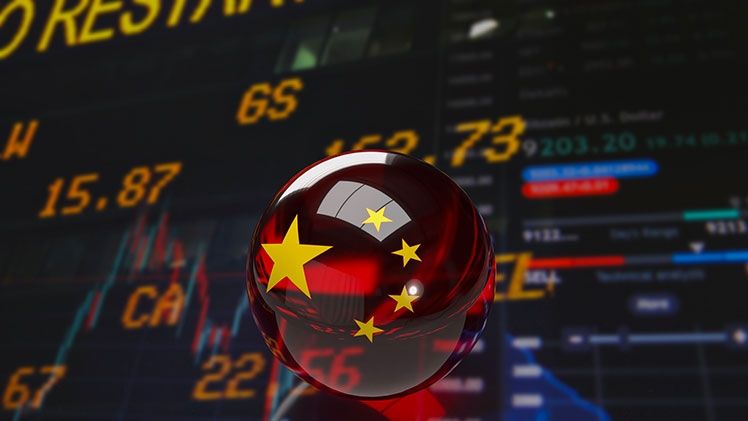China: behind involution lie deep-seated economic imbalances
- 02.10.2025
- 0
- Télécharger la publication (PDF - 291,68 KB)

Read the article
A new term has established itself in the Chinese economic lexicon: involution, denoting a situation of economic stagnation despite intensifying effort.
To use a metaphor suggested by Deutsche Bank1, imagine a full theatre where everyone is seated until one person stands up to get a better view, quickly forcing everyone in the auditorium to do likewise. The end result is that the entire audience is once again equal but now standing instead of seated.
In China’s case, this takes the form of intense competition leading to diminishing returns for all participants. In game theory, this would mean the players in a given sector deciding to step up their efforts without any additional gain, where failing to do so would mean being eliminated from the competition: a kind of Pareto suboptimality2 where a state of equilibrium is reached but through disproportionate means.
In China, the most visible manifestation of involution is the relentless price war companies have engaged in, triggering an unprecedently long episode of deflation. Chinese President Xi Jinping has called for curbs on this “disorderly” competition, which is acting as a drag on the economy. However, its roots go deep and reveal structural problems to which the Chinese economy has found no solution.
The origins of involution
The roots of involution lie in cut-throat competition between companies in one sector since 2020. With the Chinese economy severely disrupted by Covid, the authorities opted – as they often do – for supply-side stimulus. The construction sector was already under pressure: in spring 2020, the authorities published their so-called red lines preventing many developers from raising debt to finance new projects or repay earlier debt. At the same time, Beijing launched its “dual circulation” strategy aimed at developing China’s production capability, with a particular focus on the “new productive forces” identified in the five-year plan: electric vehicles, batteries and solar panels.
In short, then, a combination of three factors is at play: available public funds; a shift in investment stimulus away from the traditional construction sector and towards manufacturing; and the emergence of new transition-related sectors, part of whose output will be exported, to conquer new market segments.
The removal of some market barriers to entry, particularly in the automative sector, and local government involvement also facilitate the emergence of new players. It is clear that the “new productive forces” will ultimately be driven by private companies, with the State never far behind.
On paper, the intentions behind this strategy are laudable: China is seeking to develop new sectors and the State is supporting this shift by providing liquidity and subsidies. The rules of the game have been simplified to leave more room for natural competition and foster the development of new companies. However, the current climate shows that this policy has ultimately failed to deliver the expected results.
What hasn’t worked
Support for new sectors has mutated into fierce competition among players, resulting in excess production capacity, a price war and a consequent decline in company profitability.
Involution is a result of two concurrent phenomena: oversupply and weak domestic demand.
On the supply side, the shift to more local control and government subsidies has created a climate of competition between provinces and even between prefecture-level cities (an administrative division consisting of an urban core and surrounding rural areas) to develop and subsequently support a champion, resulting in projects being duplicated across similar sectors and the market quickly reaching saturation point.
Local governments have offered land and tax exemptions and even invested directly in some companies. Those same companies have in turn helped them achieve their targets in terms of GDP, employment and tax take despite not being sufficiently productive. Chinese bankruptcy legislation is still in its infancy and not very effective. It is difficult for a supplier or creditor to initiate legal proceedings to recover assets, even if the counterparty has already defaulted.
The result is a two-fold change. One the one hand, instead of barriers to entry, there are poorly regulated exit barriers for companies; on the other hand, local governments have tended to protect their champions, despite their difficulties, to ensure that their overall performance is not affected and that they meet their growth targets. All this has dampened the mergers, acquisitions and consolidation activity that would normally be expected to take place in a sector in a state of overcapacity.
The upshot is that companies have engaged in an intense price war that risks leaving them all in a weakened state. The case of the automotive sector is perhaps the most symptomatic of the phenomenon of involution. Auto manufacturers’ profits declined by 33% between 2017 and 2024, while sales increased by 21% over the same period. The industry’s net profit margins also plummeted from 8% to 4.3%.
The other side of the coin is weak domestic demand. China has been going through a crisis of consumer confidence since 2020. Consumers were hit first by Covid-19 and then by the real estate crisis. The job market has become more uncertain, especially for young graduates, and the trend towards setting aside precautionary savings has become even more pronounced. The lack of a real social protection system and the fact that access to public services is contingent on having a residence permit (hukou) are among the obstacles holding back the propensity to consume. Falling prices and the slump in real estate transactions – with the real estate market serving as an investment for most Chinese households – were all the incentive that was needed for households to watch their spending.
The State’s response was both tardy and lacking. The authorities launched a huge programme of subsidies for consumer goods (electronic devices, household appliances and electric vehicles). These subsidies kept retail sales figures artificially high, particularly during the second quarter of 2025. But their effects are already fading – it will take a lot more than the global Labubu phenomenon to get Chinese people excited about spending again3 : retail sales are once again growing more slowly than the economy. The hardest hit categories are precisely those that were covered by subsidy programmes, notably household equipment and mobile phones.
Combating involution
This is not the first time China has had to contend with involution. It happened before in the late 1990s, when China opened up its economy to the world and had to manage large and inefficient state-owned enterprises that were not compatible with changes in the economy, and again in 2015–2016 in the steel and cement sectors. Each time, the authorities intervened and agreed to cut production in affected sectors despite the ensuing job losses.
This time, though, the situation is different. Firstly, the production capacity in question – whether for solar panels or electric vehicles – was only installed very recently. This means it is far from being fully depreciated, especially in light of the significant capital expenditure incurred, particularly during the research and development phase. In 2015, the sectors in question were among the most outdated and in the upstream part of most value chains.
Secondly, unlike in the previous examples, this time around most of the production capacity is privately owned: private companies own 95% of the solar energy and battery market and 65% of the electric vehicle market, compared with 35% of the steel market and 50% of the cement market. While the Chinese State remains highly interventionist, it cannot interfere in the affairs of the private sector – especially given that, once again, the lack of a clear regulatory framework around bankruptcy impedes its freedom to act.
The deflation China is experiencing now is also much deeper than it was in 2015: the GDP deflator has declined for nine consecutive quarters, compared with just two in 2015, while year-to-date average inflation comes in at -0.1%, compared with 1.5% in 2015. In fact, this is the first time producer and consumer prices have simultaneously been so low for so long. The producer price index has been in decline since January 2023, while the annual change in the consumer price index has not exceeded 1% since February 2024.
In 2016, China was also helped by the recovery in international trade. This time around, the cycle looks less promising.
Trade tensions have multiplied. Exports to the US have already declined steeply. For the time being, this decline has been offset by exports via backdoor countries (notably ASEAN countries and Mexico) and to new markets, particularly in the European Union; the latter is already casting around for ways to stem this wave of goods, which is likely to further erode its industrial base.
To prevent involution contaminating other sectors, the Chinese authorities are pursuing a multi-pronged approach focused on a number of key areas:
- Legal framework: amending legislation on unfair competition by tightening the ban on selling goods at a loss and preventing larger companies from abusing their market power
- Self-discipline: working with industry groups in the relevant sectors to organise concerted voluntary cuts in production and shorten supplier payment terms so that the 60-day rule becomes the norm and is universally adopted
- Employment law: enforcing labour law, shortening working hours, capping overtime and encouraging employees to take annual leave
These measures, together with the change in tone from authorities right up to the highest levels, may have an incentivising effect. Even so, the sectors in question will not be able to sidestep the need for a real effort to adjust their production capacity. This requires a profound paradigm shift in how economic policy is conducted: it means accepting lower growth targets and identifying growth drivers not confined to the manufacturing and infrastructure sectors. In any event, rebalancing a system increasingly debilitated by its excesses will require both reducing supply and boosting demand.
Our opinion
The return of involution is not surprising: it reflects the priorities of a Chinese economy focused on supporting supply and investment, obsessed with generating returns and meeting targets set out in the many sectoral and local iterations of China’s five-year plans. To give credit where it is due, China’s gamble has partly paid off: it is utterly dominant in the battery, solar panel and electric vehicle sectors. The wider outcome remains much less certain.
The all-pervading power of central planning is undermined by its own excesses: the existence of growth targets, competition for subsidies at every level of the administration, and the requirement to deliver results have prompted local governments, in conjunction with businesses, to leave surplus production capacity in place. The lack of mechanisms for market exit – a notion at odds with a managed economy – also hampers efforts to regulate the market. The ensuing involution and deflation stem from these profound imbalances, which hark back to the roots of the Chinese model. Eliminating them would require a complete paradigm shift, particularly with regard to how quantitative targets are set. The presentation of the next five-year plan at the parliamentary sessions in March 2026 will serve as a litmus test of whether the apparent concerns of China’s leadership are translated into concrete economic policy.
References
- Understanding China's "Anti-involution" Drive - Deutsche Bank, September 2025
- Pareto optimality is the state in which resources are allocated in such a way that no economic agent can be made better off without another being made worse off.
- Labubu: the tiny elf doll driving China’s most valuable toy company, Financial Times, June 2025

The return of involution is not surprising: it reflects the priorities of a Chinese economy focused on supporting supply and investment, obsessed with generating returns and meeting targets set out in the many sectoral and local iterations of China’s five-year plans. To give credit where it is due, China’s gamble has partly paid off: it is utterly dominant in the battery, solar panel and electric vehicle sectors. The wider outcome remains much less certain.
Sophie WIEVIORKA, Economiste - Asie (hors Japon)
